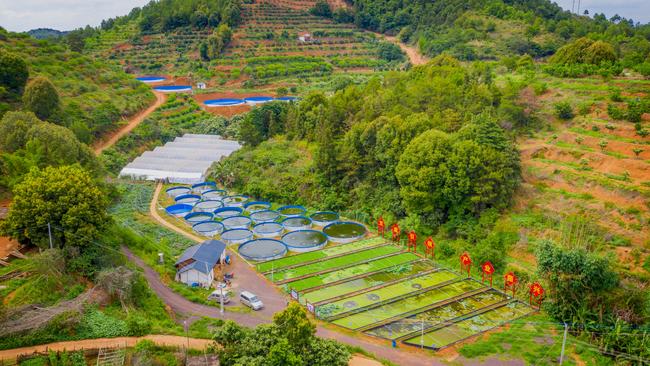Made in China: why these ‘Australian lobsters’ lay bare the true intentions of President Xi Jinping
Beijing ramps up support for made-in-China ‘Australian lobster’ – yabbies grown in Chinese fish ponds – in a brazen campaign launched after Don Farrell failed to get relief for exporters.

China’s government has ramped up support for made-in-China “Australian lobster” – actually yabbies grown in Chinese fish ponds – in a brazen campaign launched after Trade Minister Don Farrell returned to Australia without relief for exporters smashed by Beijing.
The audacious “buy Chinese” campaign is part of President Xi Jinping’s domestic production obsession, an attempt to make his country more resilient in a world he says is hostile to China.
It comes as the boss of Australia’s biggest wine company said he believed the almost 200 per cent tariff Beijing used to cripple our exports in 2020 was done in part to protect China’s local producers.
Treasury Wine Estates CEO Tim Ford said his $9.5bn drinks company was not making any profit from its made-in-China Penfolds range, an effort to align the company with Mr Xi’s rural development priorities. Before Beijing’s tariff, China was the source of one third of its profits.
“China is now essentially zero profit for us,” he confirmed, when asked by The Australian.
Treasury continues to sell domestically produced wine and other non-Australian wines in China to keep up its brand awareness, but the CEO said even if the tariff was removed the company would never go back to the fat years of the pre-2020 era. “We are not going to go back to where we were,” he said.
Other businesses targeted in Beijing’s trade attacks on exports previously worth $20b a year have told The Australian they expect any resumption of access to China’s huge market will be on terms that dramatically favour their domestic rivals.
Since 2020, China’s domestic coal producers have been given permission to mine in areas previously banned for environmental reasons, as Beijing tried to offset the blacklisting of Australian miners, which had been the biggest foreign suppliers to China.
Australian coal exporters have again been allowed clearance at China’s ports, but the volumes of both thermal and coking coal is a fraction of their 2019 levels.

In the months before the China trip by Senator Farrell – himself a wine grower – Chinese authorities cracked down on an illicit trade of live lobsters smuggled through Hong Kong and Taiwan. Some in the hugely China-exposed trade have told The Australian they are looking to leave the industry.
The Australian wine industry, far more exposed to Beijing’s interference than the coal industry, is preparing for a drastically curtained future in the world’s second biggest economy.
Treasury Wine Estates is now making a wine carrying its Penfolds label in Ningxia, one of China’s least-developed areas.
Outlining Treasury’s cautionary tale, Mr Ford said China’s government was not going to tolerate replaceable Australian businesses dominating its market at the expense of domestic rivals.
“Put the hat on if it was happening to us here in Australia as an Australian wine industry and [France], for example, was just killing it in this market and they were getting 80 per cent growth on an annual basis and our local industry was going backwards. I reckon we might be carrying on a little bit here.”
While he said the Morrison government’s “diversification” push initially grated with the industry, he said investors had now completely changed their attitude towards exposure to China.
“I’m never going to explain China as a standalone business ever again … It’s not going to happen,” he said at an event hosted by the University of Technology Sydney’s Australia-China Relations Institute.
In an eye-catching example of the threat to high-margin Australian businesses, this week the spawn of three million so-called “freshwater Australian lobsters” were launched into rice paddies-cum-aquaculture ponds in Hunan province.
JD, one of China’s e-commerce giants, is selling “fresh Australian blue lobster” – actually yabbies, which are native to Australia and are a smaller crustacean than lobster – which are reared in Guangdong province, in the country’s south. Most customer reviews give the product five stars.
China’s cultivation of “freshwater Australian lobsters” has spread around the country as relations deteriorated with Australia, including to Shandong in the east and Xinjiang in the west.

“I want to do something different … the market demand is large,” Hubei farmer Wang Bibo told Chinese media about his decision to join the industry.
Mr Wang said he learned to cultivate the native Australian crustacean on the Chinese island of Hainan in 2019.
He now runs Tianmen Aolong Agricultural Technology Co in Hubei province in central China, and released his first batch of “Australian freshwater lobsters” into his aquaculture farm in May 2020, just weeks after the Morrison government called for an inquiry in the origins of Covid-19.
Mr Wang said the Chinese industry’s biggest problem was breeding the Australian natives in China. “The reproductive rate is low, and a female shrimp only lays 100-200 eggs each time,” he said.
Australia’s biggest yabby exporter said the misleadingly marketed Chinese product risked the reputation of our local industry.
“We’ve got a reputation for a more pristine environment than China,” said Mary Nenke of the family-operated Cambinata Yabbies, based in the West Australian wheatbelt. Her export-award-winning business is run from a property that has been in her family for more than 100 hundred years and now includes a high-end eco tourist lodge, Mary’s Farm Cottages. “We really care about the land,” she told The Australian. “We don’t want our product being sold as ‘Australian’ when it’s not.”

Unlike the seawater lobster industry – whose trade to China was worth $750m before the ban – few Australian-reared yabbies have been exported to China. Europe, South Korea, Singapore and Taiwan are the biggest overseas markets for the premium yabbies.
According to Chinese party state media, the batch of fledgling crustaceans released this week in Hubei were sourced from Xiamen, a port city in China’s south west where Mr Xi was based in the 1980s. How they were originally sourced from Australia was not explained.
A local party secretary added that breeding “Australian freshwater lobsters” would help with the province’s “rural revitalisation”, a priority of China’s leader.
The propaganda push for China’s domestic “Australian” agricultural industry comes days after Beijing’s top envoy in Canberra insisted Australian concerns about “economic coercion” were a misunderstanding.
“Chinese people were angry at the wrong words and deeds of the previous Australian government and were unwilling to buy Australian goods and services,” ambassador Xiao Qian said.
Australian exports to China hit a record $180b in 2021, during the Morrison government — an inconvenient fact for Beijing’s party state media.
Most Australian exports to China are of strategically important resources, including iron ore, LNG and lithium, which Beijing can only block at great cost to itself. The economic coercion has further narrowed Australia’s exports to China.
China’s government is using negotiations over the remaining trade strikes as leverage as it asks Canberra to back Beijing’s entry into the Comprehensive and Progressive Agreement for Trans-Pacific Partnership, the world’s highest-standard trade grouping.which was created after a push by Australia and Japan — who have both been on the wrong end of Chinese trade coercion.
China is currently threatening Canada, a fellow founding member of the CPTPP, with “strong reactions” after Ottawa accused Beijing of interfering with its democracy. Accession to the trade group requires the unanimous support of all of its 11 members.




To join the conversation, please log in. Don't have an account? Register
Join the conversation, you are commenting as Logout